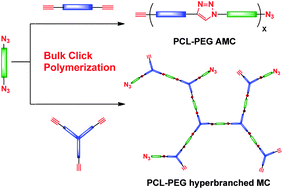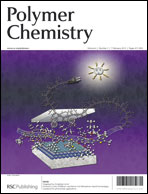Fast bulk click polymerization approach to linear and hyperbranched alternating multiblock copolymers†
Abstract
A novel bulk click polymerization (BCP) approach was determined to prepare alternative multiblock copolymers (AMCs). Poly(ε-caprolactone) (PCL) and polyethylene glycol (PEG) were first modified into azide and alkyne terminated macromonomers by esterification, respectively. Subsequent azide–alkyne click polymerization of the two macromonomers in bulk without any solvents using CuBr/N,N,N′,N′′,N′′-pentamethyldiethylenetriamine (PMDETA) as a catalyst system afforded AMCs with higher degrees of polymerization (DPs) than those obtained via solution polymerization (SP) in the control experiments. Through this approach, within 1 h (normally 5 min), AMCs were obtained with high DPs of up to 16, as revealed by gel permeation chromatography (GPC). Studies on the thermal properties of the AMCs showed that the alternating structure confined the crystallizations of the PCL and PEG blocks. The solution self-assembly behavior of the amphiphilic AMCs was investigated for the first time, and interesting structures such as globules, fibers, and worms were observed by means of atomic force microscopy (AFM). Additionally, hyperbranched AMCs were also prepared via an A2 + B3 strategy.


 Please wait while we load your content...
Please wait while we load your content...